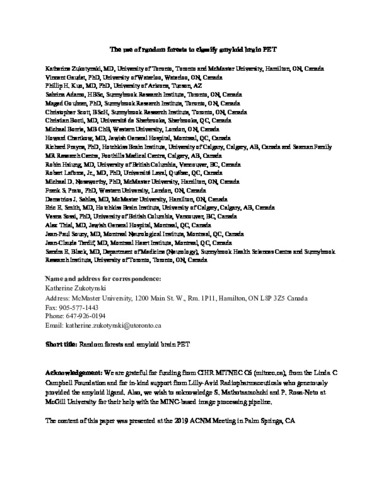| dc.contributor.author | Zukotynski, Katherine | |
| dc.contributor.author | Gaudet, Vincent C. | |
| dc.contributor.author | Kuo, Phillip H. | |
| dc.contributor.author | Adamo, Sabrina | |
| dc.contributor.author | Goubran, Maged | |
| dc.contributor.author | Scott, Christopher | |
| dc.contributor.author | Bocti, Christian | |
| dc.contributor.author | Borrie, Michael | |
| dc.contributor.author | Chertkow, Howard | |
| dc.contributor.author | Frayne, Richard | |
| dc.contributor.author | Hsiung, Robin | |
| dc.contributor.author | Laforce, Robert | |
| dc.contributor.author | Noseworthy, Michael D. | |
| dc.contributor.author | Prato, Frank S. | |
| dc.contributor.author | Sahlas, Demetrios J. | |
| dc.contributor.author | Smith, Eric E. | |
| dc.contributor.author | Sossi, Vesna | |
| dc.contributor.author | Thiel, Alexander | |
| dc.contributor.author | Soucy, Jean-Paul | |
| dc.contributor.author | Tardif, Jean-Claude | |
| dc.contributor.author | Black, Sandra E. | |
| dc.date.accessioned | 2023-11-03 17:38:19 (GMT) | |
| dc.date.available | 2023-11-03 17:38:19 (GMT) | |
| dc.date.issued | 2019-10 | |
| dc.identifier.uri | https://doi.org/10.1097/rlu.0000000000002747 | |
| dc.identifier.uri | http://hdl.handle.net/10012/20083 | |
| dc.description | Copyright © 2019 Wolters Kluwer Health, Inc. All rights reserved. | en |
| dc.description.abstract | Purpose: To evaluate random forests (RFs) as a supervised machine learning algorithm to classify amyloid brain PET as positive or negative for amyloid deposition and identify key regions of interest for stratification.
Methods: The data set included 57 baseline 18F-florbetapir (Amyvid; Lilly, Indianapolis, IN) brain PET scans in participants with severe white matter disease, presenting with either transient ischemic attack/lacunar stroke or mild cognitive impairment from early Alzheimer disease, enrolled in a multicenter prospective observational trial. Scans were processed using the MINC toolkit to generate SUV ratios, normalized to cerebellar gray matter, and clinically read by 2 nuclear medicine physicians with interpretation based on consensus (35 negative, 22 positive). SUV ratio data and clinical reads were used for super- vised training of an RF classifier programmed in MATLAB.
Results: A 10,000-tree RF, each tree using 15 randomly selected cases and 20 randomly selected features (SUV ratio per region of interest), with 37 cases for training and 20 cases for testing, had sensitivity = 86% (95% confidence in- terval [CI], 42%–100%), specificity = 92% (CI, 64%–100%), and classification accuracy = 90% (CI, 68%–99%). The most common features at the root node (key regions for stratification) were (1) left posterior cingulate (1039 trees), (2) left middle frontal gyrus (1038 trees), (3) left precuneus (857 trees), (4) right an- terior cingulate gyrus (655 trees), and (5) right posterior cingulate (588 trees). Conclusions: Random forests can classify brain PET as positive or negative for amyloid deposition and suggest key clinically relevant, regional features for classification. | en |
| dc.description.sponsorship | CIHR MITNEC C6 || Linda C Campbell Foundation || Lilly-Avid Radiopharmaceuticals. | en |
| dc.language.iso | en | en |
| dc.publisher | Wolters Kluwer Health | en |
| dc.relation.ispartofseries | Clinical Muclear Medicine;44(10) | |
| dc.subject | amyloid | en |
| dc.subject | brain PET | en |
| dc.subject | dementia | en |
| dc.subject | machine learning | en |
| dc.subject | random forest | en |
| dc.title | The use of random forests to classify amyloid brain PET | en |
| dc.type | Article | en |
| dcterms.bibliographicCitation | Zukotynski, K., Gaudet, V., Kuo, P. H., Adamo, S., Goubran, M., Scott, C., Bocti, C., Borrie, M., Chertkow, H., Frayne, R., Hsiung, R., Laforce, R., Noseworthy, M. D., Prato, F. S., Sahlas, D. J., Smith, E. E., Sossi, V., Thiel, A., Soucy, J.-P., Tardif, J.C. & Black, S. E. (2019). The use of random forests to classify amyloid brain pet. Clinical Nuclear Medicine, 44(10), 784–788. https://doi.org/10.1097/rlu.0000000000002747 | en |
| uws.contributor.affiliation1 | Faculty of Engineering | en |
| uws.contributor.affiliation2 | Electrical and Computer Engineering | en |
| uws.typeOfResource | Text | en |
| uws.peerReviewStatus | Reviewed | en |
| uws.scholarLevel | Faculty | en |

